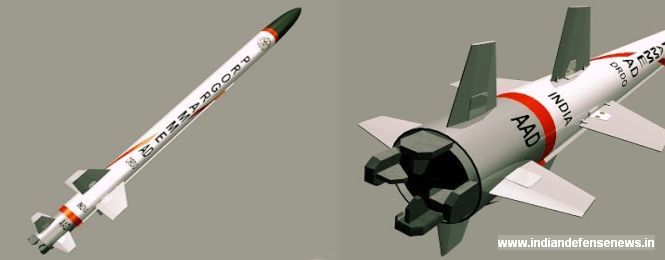On 29th December 2017, an Advanced Ashwin Air Defense projectile lifted off from Kalam island in Orissa and in a perfect interception, destroyed an incoming Prithvi ballistic missile within 30 kilometers of earth atmosphere. In doing so, the AAD missile in its final deployment configuration met all its mission parameters, paving the way for an early induction of the system in IAF. This would make it the 14th test of the Ashwin AAD missile through its development history, with only less than two failures and notable successes of it various versions. This is yet another validation of Indian missile development efforts, which have stepped up to provide India with the critical defense technologies either not created before or unavailable for acquisition for love or for money.
In this specific case the technology comparable to what was tested recently, is present with only three other countries in the world, namely Russia, USA and Israel. Interestingly the Indian journey towards indigenous development of anti-ballistic missile started when US blocked the sale of Arrow anti-ballistic missile defense system (anti-BMD) systems from Israel to India in 2002, as a co-developer a major funding contributor towards that program. The wheel has now come full circle with US keen to sell its Patriot system to India, and India no longer being interested in purchasing the same.
Standing at 7.5 meters in length, with a diameter less than 0.5 meters, the 1200 Kg solid fueled Ashwin AAD missile, is potent counter for enemy intermediate or a medium range ballistic missile of ranges around 2000 km.
Some of the specifications of the system are not easily publicly available and have to be read from various different statements from senior government functionaries. For example, the on the record statement of erstwhile head of DRDO and scientific advisor to RM Dr VK Saraswat in 2012 itself mentioning that AAD was at least 20% more capable than PAC-3, gives us key insight to the system performance.
Going by the previous data point, Ashwin AAD missile would have an interception ranges of around 100 kms. This would also give it an operational celling, that is the maximum height that the weapon can reach of around 30 kilometers, which is also in keeping with the information available from other sources. With the given parameters, Ashwin compares very favorably to other weapon systems in its class, placing it somewhere between the US THAAD and PAC-3, with very similar capabilities as Israeli Arrow-2, and overlapping with the capabilities of multi-layered S-400 Triumf system.
A major “un-glamorous” component of the BMD which gets tested along with the kill vehicles themselves are the ground based radars. These provide the eyes and ears of the protective envelop, looking out for enemy threats, acquiring them and directing the missiles towards their targets. In case of Indian BMD systems, it is the Swordfish long range tracking radar (LRTR) which is an active electronically scanned array radar of developed on the base on Israeli Green Pine radar. The Green Pine radar is the early-warning radar which goes into the Arrow system, but the Indian Swordfish replaces many of the hardware components with Indian modules and adds command and control capabilities on top of the radar system. At 600 km detection ranges, it is slightly powerful than the original, and is comparable to S-400’s and THAAD’s radar systems in active tracking and fire control modes.
At this point, it is important to note that as effective as the AAD system is, it is only the second layer of Indian anti-BMD systems. The same radar and ground control system is used not only for AAD but also for Prithvi Air Defense/Pradyumna defense vehicle PAD/PDV missiles, which provide for the first layer of the Indian BMD capabilities, with AAD providing the second. The PAD/PDV provide for exo-atmospheric kill on an incoming target, that is these missile would destroy an enemy before it can enter the atmosphere itself, at over 80 kilometers height range. The Ashwin AAD missiles provide for endo-atmospheric kill, which would be within the atmosphere, if the first interception fails. Together they would provide for a greater than 99.8% kill probability, for missiles launched at us from as far as 5000 kilometers.
This would provide a robust shield for nearly any incoming attack, including the ones from China. However, for Pakistan, whose MRBM missile inventory is composed primarily of Hatf V/VI (Ghauri/Shaheen) missile of ranges up to 2000 Km, the current AAD would also be able to achieve a high probability of success when fired in a salvo mode, that is multiple 2-3 interceptors against a target. This would be similar to the approach followed by Israel with Arrow-2 systems. In addition given the very short flight times of IRBM/MRBM from Pakistan to Indian cities, with times less than 10 minutes, possibly only a endo-atmospheric interdiction would be feasible, making AAD the counter of choice against Pakistani attacks. Already two sites in Rajasthan in Alwar and Pali districts have been identified by GoI for basing LRTR and other observational measures for keeping an eye on Pakistan. This would enable virtually all of Pakistan to be covered by Indian radars for threats against New Delhi and Mumbai.
While the Phase II of anti-BMD program gets ready in shape of PDV induction, the current first layer maintained by limited numbers of PAD, coupled with the very effective second layer of hit-to-kill AAD provide for a very robust defense against Pakistani MRBM/IRBM threat.
